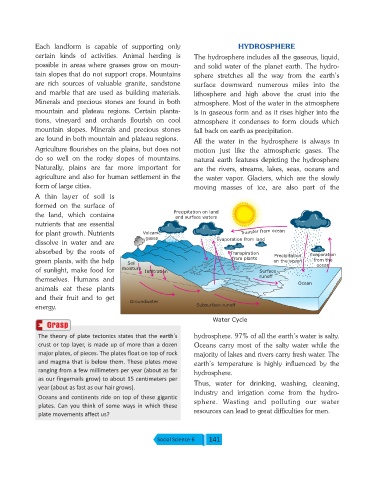Page 141 - SST Class 06
P. 141
Each landform is capable of supporting only HYDROSPHERE
certain kinds of activities. Animal herding is The hydrosphere includes all the gaseous, liquid,
possible in areas where grasses grow on moun- and solid water of the planet earth. The hydro-
tain slopes that do not support crops. Mountains sphere stretches all the way from the earth’s
are rich sources of valuable granite, sandstone surface downward numerous miles into the
and marble that are used as building materials. lithosphere and high above the crust into the
Minerals and precious stones are found in both atmosphere. Most of the water in the atmosphere
mountain and plateau regions. Certain planta- is in gaseous form and as it rises higher into the
tions, vineyard and orchards flourish on cool atmosphere it condenses to form clouds which
mountain slopes. Minerals and precious stones fall back on earth as precipitation.
are found in both mountain and plateau regions. All the water in the hydrosphere is always in
Agriculture flourishes on the plains, but does not motion just like the atmospheric gases. The
do so well on the rocky slopes of mountains. natural earth features depicting the hydrosphere
Naturally, plains are far more important for are the rivers, streams, lakes, seas, oceans and
agriculture and also for human settlement in the the water vapor. Glaciers, which are the slowly
form of large cities. moving masses of ice, are also part of the
A thin layer of soil is
formed on the surface of
the land, which contains Precipitation on land
and surface waters
nutrients that are essential
for plant growth. Nutrients Volcanic r T a n s fe r fr om ocean
gases Evaporation from land
dissolve in water and are
absorbed by the roots of Transpiration Precipitation Evaporation
green plants, with the help Soil from plants on the ocean from the
ocean
of sunlight, make food for moisture Infiltration Surface
themselves. Humans and runoff
Ocean
animals eat these plants
and their fruit and to get
Groundwater
energy. Subsurface runoff
Water Cycle
The theory of plate tectonics states that the earth’s hydrosphere. 97% of all the earth’s water is salty.
crust or top layer, is made up of more than a dozen Oceans carry most of the salty water while the
major plates, of pieces. The plates float on top of rock majority of lakes and rivers carry fresh water. The
and magma that is below them. These plates move earth’s temperature is highly influenced by the
ranging from a few millimeters per year (about as far
hydrosphere.
as our fingernails grow) to about 15 centimeters per
Thus, water for drinking, washing, cleaning,
year (about as fast as our hair grows).
industry and irrigation come from the hydro-
Oceans and continents ride on top of these gigantic
sphere. Wasting and polluting our water
plates. Can you think of some ways in which these
resources can lead to great difficulties for men.
plate movements affect us?
Social Science-6 141

